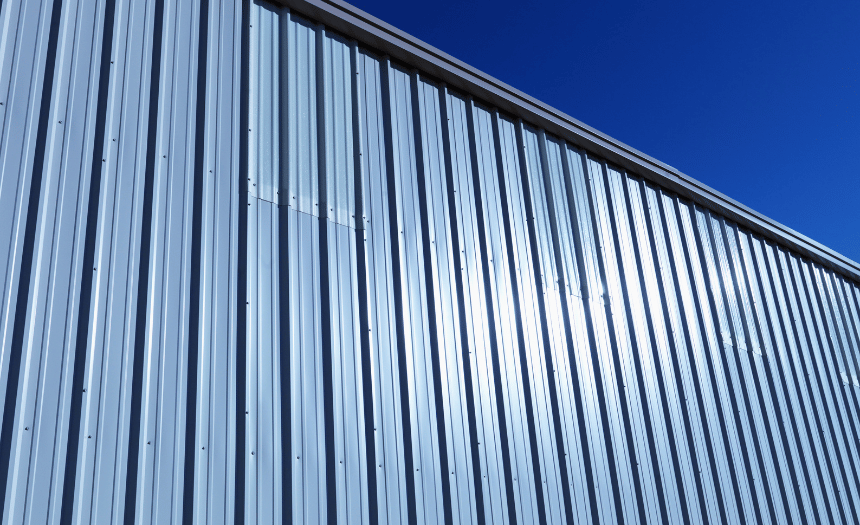When it comes to painting metal siding on a house, there are key steps and considerations that can make a significant difference in the outcome. This guide is designed to equip you with essential knowledge to tackle this project successfully, ensuring a lasting and visually appealing finish.
Preparation for Painting Metal Siding

When it comes to painting metal siding on a house, proper preparation is key to achieving a long-lasting and professional finish. This involves gathering the necessary materials, cleaning and prepping the surface, and following specific steps to ensure the paint adheres correctly.
Materials Needed:
- Pressure washer or hose with spray nozzle
- Detergent or cleaner suitable for metal surfaces
- Scrub brush or sponge
- Sandpaper or wire brush
- Primer designed for metal surfaces
- Exterior paint suitable for metal siding
- Paint roller, brushes, or sprayer
- Drop cloths or plastic sheeting
- Painter's tape
- Safety goggles and gloves
- Ladder or scaffolding
Importance of Cleaning and Prepping:
Before painting metal siding, it is crucial to thoroughly clean and prep the surface. This ensures that the paint will adhere properly and result in a smooth and durable finish. Dirt, grease, and other contaminants can prevent the paint from sticking, leading to peeling and chipping over time.
Steps for Preparing Metal Siding:
- Start by washing the siding with a pressure washer or hose to remove dirt, grime, and loose paint.
- Use a detergent or cleaner suitable for metal surfaces to remove grease and other stubborn stains.
- Scrub the surface with a brush or sponge to ensure all debris is removed.
- Rinse the siding thoroughly and allow it to dry completely before proceeding.
- Inspect the siding for any rust spots or areas with flaking paint. Use sandpaper or a wire brush to smooth out these imperfections.
- Apply a primer designed for metal surfaces to ensure proper adhesion and corrosion resistance.
- Once the primer is dry, you can proceed to apply the exterior paint using a roller, brushes, or sprayer for even coverage.
- Allow the paint to dry completely between coats as per the manufacturer's instructions.
- Remove any painter's tape and protective coverings once the paint has dried to reveal a beautifully painted metal siding.
Choosing the Right Paint

Choosing the right paint for metal siding is crucial to ensure a long-lasting and durable finish. Different types of paints are available in the market, each with its own advantages and considerations.Oil-based paints are traditional choices for metal surfaces due to their durability and ability to adhere well to metal.
They provide a tough finish that is resistant to scratches and harsh weather conditions. However, they tend to take longer to dry and may emit strong odors during application.On the other hand, latex-based paints have become increasingly popular for metal siding due to their quick drying time and easy cleanup with water.
They also offer flexibility and breathability, allowing for expansion and contraction of the metal. While latex paints may not be as durable as oil-based paints, they are more environmentally friendly and have low levels of volatile organic compounds (VOCs).It is essential to select a high-quality paint specifically designed for metal surfaces.
High-quality paints offer better adhesion, color retention, and protection against rust and corrosion. Investing in quality paint can save you time and money in the long run by reducing the frequency of repainting and maintenance.
Significance of Selecting High-Quality Paint
- High-quality paints provide better adhesion to metal surfaces, ensuring long-lasting durability.
- Quality paints offer superior protection against rust, corrosion, and harsh weather conditions.
- Color retention is higher in high-quality paints, maintaining the aesthetic appeal of your home for longer periods.
- Quality paints require fewer coats, saving time and effort during the painting process.
- Investing in high-quality paint can result in cost savings by reducing the frequency of repainting and maintenance.
Application Techniques
When it comes to painting metal siding on a house, using the right application techniques is crucial for achieving a professional-looking finish
Using Brushes, Rollers, or Sprayers
- Brushes: When using brushes, opt for high-quality synthetic bristle brushes that are specifically designed for use with metal surfaces. Start by cutting in around the edges and corners with a brush before using a roller or sprayer for larger areas.
- Rollers: Use a high-density foam roller for smooth metal siding surfaces. Roll the paint in a vertical direction to prevent streaking and ensure even coverage. Be sure to work in small sections to avoid the paint drying too quickly.
- Sprayers: If using a sprayer, adjust the nozzle to achieve a fine mist and maintain a consistent distance from the siding to prevent drips or uneven coverage. Practice on a test surface before applying paint to the entire area.
Achieving a Smooth and Even Finish
- Prepare the surface: Clean the metal siding thoroughly and remove any rust or old paint before applying a primer to ensure better adhesion of the paint.
- Apply multiple thin coats: Instead of trying to cover the surface with one thick coat, apply several thin coats of paint. This will help prevent drips and ensure a smooth, even finish.
- Work in optimal conditions: Choose a day with moderate temperature and low humidity to paint metal siding. Avoid painting in direct sunlight or windy conditions to prevent the paint from drying too quickly or debris from sticking to the wet paint.
- Finishing touches: After painting, carefully inspect the surface for any missed spots or imperfections. Touch up as needed and allow the paint to fully cure before exposing it to harsh weather conditions.
Weather Considerations
When painting metal siding on a house, weather conditions play a crucial role in the success of the project. The temperature, humidity levels, and precipitation can all impact the application and drying process of the paint.
Ideal Temperature and Humidity Levels
For painting exterior metal siding, it is recommended to work in temperatures between 50°F and 85°F. Extreme heat can cause the paint to dry too quickly, leading to a poor finish, while cold temperatures can prevent proper adhesion. Additionally, humidity levels should ideally be between 40% and 70% to ensure the paint dries evenly and doesn't blister or bubble.
Recommendations for Different Seasons
During the summer months, aim to paint early in the morning or late in the afternoon to avoid the peak heat of the day. In winter, try to paint on a sunny day when temperatures are above freezing to allow the paint to dry properly.
Fall and spring are typically good seasons for painting, as the weather is more moderate.
Maintenance and Longevity
Maintaining the painted metal siding on your house is crucial for ensuring its longevity and keeping it looking fresh. Regular upkeep and proper care can significantly extend the lifespan of the paint job on metal surfaces.
Steps to Maintain Painted Metal Siding
- Regularly clean the metal siding with a mixture of mild soap and water to remove dirt, dust, and debris that can degrade the paint over time.
- Inspect the siding for any signs of chipping, cracking, or peeling paint, and address these areas promptly by sanding, priming, and repainting as needed.
- Trim back any vegetation or bushes that may be in contact with the metal siding to prevent moisture buildup and potential damage to the paint.
- Consider applying a fresh coat of paint every 5-10 years to maintain the appearance and protection of the metal siding.
Repainting Frequency for Metal Siding
Repainting metal siding may be necessary every 5-10 years, depending on factors such as the climate, sun exposure, and overall wear and tear on the paint.
Tips for Extending Lifespan of Paint Job
- Choose high-quality paint specifically formulated for metal surfaces to ensure durability and long-lasting color retention.
- Apply a primer before painting to enhance adhesion and provide an extra layer of protection against the elements.
- Avoid using harsh chemicals or abrasive cleaners on the painted metal siding, as these can damage the paint and shorten its lifespan.
- Regularly inspect the siding for any signs of damage or wear, and address any issues promptly to prevent further deterioration.
Epilogue
In conclusion, painting metal siding on a house requires careful preparation, the right paint selection, proper application techniques, and maintenance for longevity. By following these guidelines, you can transform the exterior of your home and protect it for years to come.
Essential Questionnaire
How often should I repaint my metal siding?
Repainting metal siding is typically needed every 5-10 years, depending on the quality of the previous paint job and exposure to elements.
What is the ideal temperature for painting metal siding?
The ideal temperature for painting metal siding is between 50-85 degrees Fahrenheit, with low humidity levels to ensure proper drying.
Can I use a roller to paint metal siding?
Yes, a roller can be used to paint metal siding, but it's important to choose the right nap length for the surface texture and apply the paint evenly.


